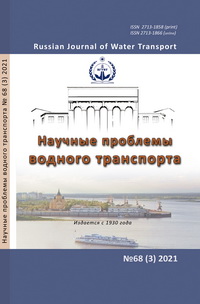Analysis of heavy floating cranes and features of their operation
Abstract
The main characteristics of offshore heavy floating cranes, which are independent navigation without tugs and the performance of cargo operations in open waters with wind and waves, are considered. The safety of navigation in these conditions can be ensured with high seaworthiness and maneuverability by giving the appropriate shape of the bow end of the hull, the minimum windage of the structure, as well as the optimal design of the topside (crane). The requirements for the design and construction of universal heavy sea floating cranes, built after 1966, are analyzed, the operating conditions, depending on the purpose, and the architectural and structural type of floating cranes with a lifting capacity of 100–900 tons are considered. When calculating the strength of the topside, the possibility of the floating crane operating with the maximum load was taken into account when the sea is rough up to three points and the wind is up to five points, taking into account the dynamic and inertial loads arising from rolling in waves, when picking up and breaking the load. In the event of an emergency breakage of the load, the structure of the topside and the boom system must exclude or minimize vibrations caused by the breakage of the load. The results of the calculation of the forces at the breakage of the load must be verified by full-scale tests of floating head cranes, for which the corresponding methods have been developed. The possibility of using the developed structure of the hull and the topside (crane) in the design and construction of modern floating cranes in the production conditions of shipyards is shown.
References
Великосельский Н. Д,., Берхин И. М. Отечественная конструкция тяжелого плавучего плавкрана / Н. Д. Великосельский, И. М. Берхин // Судостроение. – 1973. – № 4. – С. 17–21.
Берхин И. М., Гудзе А. А., Рудак Г. И. Совершенствование конструкции верхних строений отечественных плавкранов / И. М. Берхин, А. А. Гудзе, Г. И. Рудак // Судостроение. – 1973. – №4. – С. 29–31.
Гудзе А. А., Игнатович В. С., Окулов Д. И. Развитие металлических конструкций стрел тяжелых плавучих кранов / А. А. Гудзе, В. С. Игнатович, Д. И. Окулов // Судостроение. – 1973. – № 4. – С. 32–36.
Цыпина З. Д., Игнатович В. С. Определение жесткости верхних строения плавкрана «Богатырь» / З. Д. Цыпина, В. С. Игнатович // Судостроение. – 1973. – № 4. – С. 36–37.
Фриж В. А., Авдеев О. В. Особенности постройки и испытаний тяжелых плавкранов / В. А. Фриж, О. В. Авдеев // Судостроение. – 1973. – № 4. С. 64–67
Игнатович В. С. Динамическая прочность стрелы плавучего крана при обрыве груза / В. С. Игнатович // Судостроение. – 1977. – № 2. – С. 9–14.
Мохов Ю. Н., Игнатович В. С., Рожнов Г. Н. Особенности испытаний плавучих кранов большой грузоподъемности на обрыв груза / Ю. Н. Мохов, В. С. Игнатович, Г. Н. Рожнов //Технология судостроения. – 1975. – № 5. – С 47–51.
Мохов Ю. Н. Анализ опыта эксплуатации плавкранов и крановых судов/Ю. Н. Мохов //Судостроение. – 1991. – № 11. – С. 15–19.
Мохов Ю. Н. Режимы использования отечественных плавучих кранов в эксплуатации/ Ю. Н. Мохов //Судостроение. – 1992. – №4. – С. 7–10.
Новиков А. И. Режимы работы и годовая производительность плавучих кранов /А. И. Новиков //Севастополь: Издательство СевНТУ, 2003. – 228 с.
Шестакова И. Н., Беседин А. Ф., Кузьмин Д. В. История плавкраностроения на Севморзаводе /И. Н. Шестакова, А. Ф. Беседин, Д. В. Кузьмин //Судостроение. – 1986. – № 6. – С. 71–76.
Морева И.Н., Дьячук Н.С. Морские плавучие краны / И.Н. Морева, Н.С. Дьячук // Актуальные вопросы проектирования, постройки и эксплуатации морских судов и сооружений. Труды региональной научно-практической конференции. Научный редактор В.И. Истомин. – «Севастопольский государственный университет» – 2018. – С. 176–180.
Балашов М. Г. Модельные исследования ходкости полупогружных плавучих кранов / М. Г. Балашов // Вестник СевНТУ: Сб. науч. Тр. – Севастополь. – 2009. – №88. – С. 34.
Балашов М. Г., Новиков А. И. Распределение бюджета времени при эксплуатации строительно-монтажного плавучего крана /М. Г. Балашов, А. И. Новиков //Вестник СевНТУ: Сб. науч. Тр. – Севастополь. – 2007. – № 75. – С. 34.
Chen, H., Sun, N. An Output Feedback Approach for Regulation of 5-DOF Offshore Cranes With Ship Yaw and Roll Perturbations (2021) IEEE Transactions on Industrial Electronics.
http://ieeexplore.ieee.org/xpl/tocresult.jsp?isnumber=5410131 doi: 10.1109/TIE.2021.3055159
Lv T. a, Du H. b Automatic Calculation Method for Mechanical Load of Full Rotation Crane Ship Based on Flow Function Theory (2020) Journal of Coastal ResearchТом 103, Выпуск sp1, Pages 412 – 416 doi: 10.2112/SI103-084.1
Ji Y., Wang H., Chen H., Guo M. Research on Hydraulic Speed Control System of Ship Crane Anti-Rolling Device (2016) IOP Conference Series: Earth and Environmental Science. Том 295, Выпуск 426 July 2019 Номер статьи 0421302019 5th International Conference on Energy Materials and Environment Engineering, ICEMEE 2019, 12 April 2019 - 14 April 2019 doi: 10.1088/1755-1315/295/4/042130
Nesin D. Y. Platform Design for Arctic Shallow Waters [Text] / D. Y. Nesin, B. R. Livshyts, V. F. Lenskiy // Proceedings of the Twenty-second ISOPE. – ISOPE, 2012. – 22. – pp.1348 – 1352.
Nesin D. Numerical Model of the Large Carrying Capacity Crane Ship with the Fully Revolving Topside [Text] / D. Nesin, V. Dushko // Procedia Engi-neering 100 (2015) – Elsevier Ltd, Amsterdam, the Netherlands, 2015 – pp. 1082 – 1091.
Copyright (c) 2021 Russian Journal of Water Transport

This work is licensed under a Creative Commons Attribution 4.0 International License.













